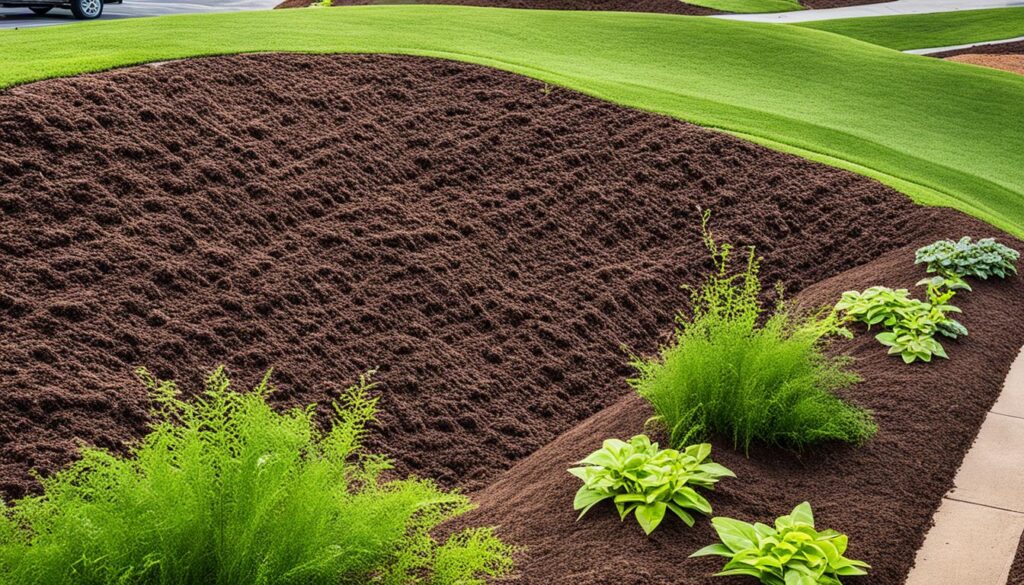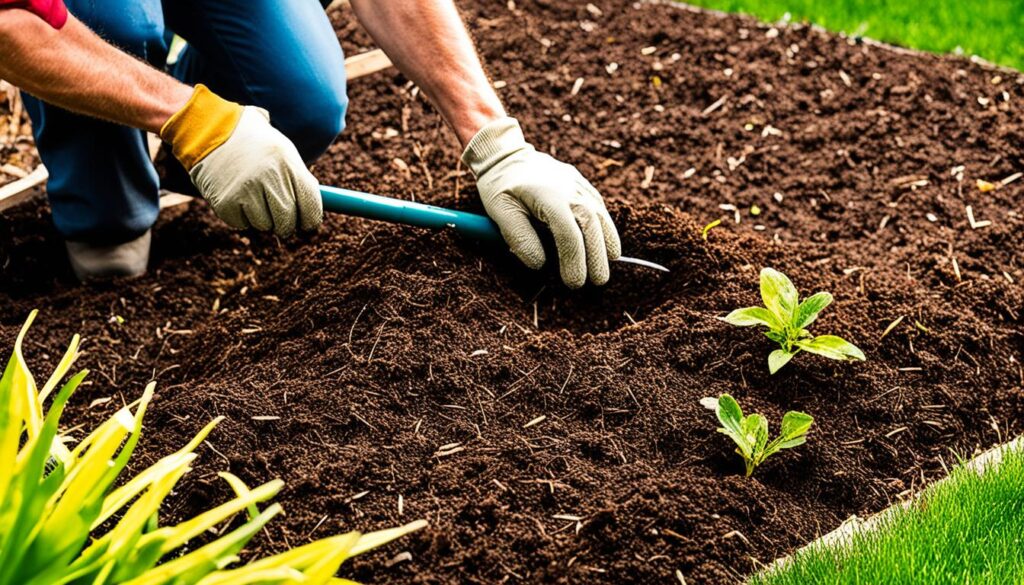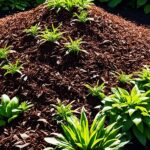The Benefits of Mulching and How to Apply It Correctly
Have you ever thought about the power of mulch? It’s more than just pretty to look at. Mulch can change your garden for the better, making it more beautiful and productive. We’ll show you how mulching can help with weed control, keep soil moist, and boost your garden’s health and look.
Get ready to see the magic of mulching and learn how to use it right for the best results.
Key Takeaways
- Mulching reduces weed growth, keeping your garden neat and tidy.
- Mulch helps retain soil moisture, reducing the need for frequent watering.
- Applying mulch regulates soil temperature, protecting plant roots from extreme heat or cold.
- Mulching improves soil structure and overall health, supporting the growth of healthy plants.
- Mulch can enhance the curb appeal of your outdoor spaces, adding a finishing touch of elegance.
But did you know the right way to apply mulch is key to its benefits? Learn the best techniques to make your garden flourish with mulching. Find out more in the next sections and turn your outdoor space into a beautiful, sustainable oasis.
What is Mulching?
Mulching is a way to protect soil by adding a layer of material on top. This layer, called mulch, comes from different sources. Organic mulch materials like wood chips and leaves help soil health as they break down. Inorganic mulch such as gravel lasts longer and needs less upkeep.
Definition and Types of Mulch
Mulch is any material spread on soil to protect it. It helps control weeds and keeps soil moist. Knowing the types of mulch helps pick the best one for your garden.
There are two main kinds of mulch:
- Organic mulch: Comes from things like wood chips and leaves. These materials add nutrients to the soil as they decompose.
- Inorganic mulch: Includes materials like gravel and rubber. These types of mulch last a long time and are easy to care for.
Choosing between organic and inorganic mulch depends on your garden’s needs and your preferences. Knowing the differences between types of mulch helps you make the right choice for your garden.
Mulching Reduces Weed Growth
Mulching is great for stopping weeds in your garden. It puts a barrier that blocks sunlight and smothers weed seeds. This means you spend less time pulling weeds and can enjoy gardening more.
Keeping a 2-4 inch layer of mulch helps keep weeds away and helps your plants grow well. It acts as a weed barrier, stopping weed seeds from getting the sunlight and warmth they need. This stops weed germination and cuts down on weeds in your garden.
Mulch also stops weed roots from getting through, making it hard for weeds to survive. This mix of physical and environmental barriers makes mulching a strong way to keep your garden weed-free.
“Mulching is one of the most effective ways to control weeds in a garden. The layer of mulch blocks sunlight and smothers weed seeds, preventing them from germinating.”
Adding mulching to your gardening routine cuts down on the work needed for weed control. You get a beautiful, easy-to-maintain garden with less effort.
Moisture Retention and Water Conservation
Water conservation is key for a lush, vibrant garden. Mulch is a great tool for this. It covers the soil, reducing evaporation and keeping moisture in the soil longer. This means you water your plants less often, saving time, money, and resources.
The type of mulch you use matters for water saving. Coarser mulches like wood chips or pine bark let water soak into the soil easily. Finer mulches, such as shredded leaves or compost, create a barrier that stops water from running off. Choosing the right mulch can make your garden more water-efficient and keep your plants healthy.
How Mulch Helps Retain Soil Moisture
Mulch acts as a shield, protecting the soil from the sun and wind. This slows down evaporation, keeping moisture in the soil for your plants. With higher soil moisture, you water less often, saving water and supporting drought-tolerant gardening.
| Mulch Type | Water Penetration | Evaporation Reduction |
|---|---|---|
| Coarse (Wood Chips, Pine Bark) | High | Moderate |
| Fine (Shredded Leaves, Compost) | Moderate | High |
Adding mulch to your garden can change the game for water use. By picking the right mulch and applying it right, you get a lush garden with less water use. This also helps your soil stay healthy over time.
“Mulch is a gardener’s secret weapon for water conservation. It’s a simple, yet highly effective way to keep your plants hydrated and your water bills low.”
Regulates Soil Temperature
Mulch is a key tool for keeping your soil at the right temperature. It acts like insulation, keeping the soil at a good temperature for your plants all year.
In summer, mulch keeps the soil cool, protecting your plants’ roots from the heat. This is especially important for young plants that can’t handle big temperature changes.
In winter, mulch keeps the soil warm, protecting your plants from frost. It stops sudden drops in temperature, keeping your plants’ roots safe and warm.
Mulch makes a great environment for your plants to grow. It helps with root growth and keeps your plants healthy. Mulch is a big help in keeping your soil temperature right, whether it’s hot or cold.
“Mulch is like a cozy blanket for your soil, protecting it from the harsh extremes of nature.”
Mulch keeps the soil temperature steady, helping your plants grow strong. This is key for gardening success. A layer of mulch can really improve your plants’ health and growth.
Improves Soil Health and Structure
Choosing organic mulches like wood chips or leaves does more than make your garden look good. It also boosts the health and structure of your soil. As these mulches decompose over time, they add important soil organic matter. This is key for soil fertility.
This process helps the soil microbiome grow. This includes microorganisms and earthworms that are crucial for nutrient cycling and soil structure.
The decomposing mulch also makes the soil better for water and roots. It helps plants grow strong and healthy. By using mulch, you’re making your garden’s soil healthier and more productive over time.
| Benefits of Mulching for Soil Health | Impact |
|---|---|
| Increases soil organic matter | Enhances soil fertility and structure |
| Encourages beneficial soil microorganisms | Improves nutrient cycling and soil aggregation |
| Promotes better water infiltration and root penetration | Supports overall plant health and growth |
Adding mulch to your garden does more than make it look nice. It’s a way to invest in your soil’s health and productivity. This simple step can change your garden, making it a place for healthy plants and a beautiful outdoor space.
“Healthy soil is the foundation for productive, sustainable agriculture.” – USDA Natural Resources Conservation Service
Prevents Erosion and Compaction
Mulching is key to a healthy garden. It fights the bad effects of soil erosion and soil compaction. Mulch covers the soil, protecting it from wind, rain, and foot traffic.
Mulch absorbs raindrops, slowing down water runoff. This lets the soil soak up moisture better. It lowers the chance of soil erosion and keeps the soil’s structure right, stopping it from getting hard and compacted.
In busy spots, mulch is a must for protecting soil structure. It acts as a shock absorber, stopping the soil from getting packed down by people or machines. This helps roots grow strong and plants stay healthy, making your garden better.
Adding mulch to your garden is a smart move for its long-term health and productivity. It keeps your soil safe from erosion and compaction. This means your garden will stay lively and support your plants for many years.
Learn more about mulching and how it keeps your soil fertile and safe.

“Mulch is a garden’s best friend, shielding soil from the elements and nurturing its structure for healthier, more vigorous plants.”
| Benefit | Impact |
|---|---|
| Prevents Soil Erosion | Mulch acts as a protective layer, absorbing the impact of raindrops and slowing down water runoff, allowing the soil to absorb moisture more effectively. |
| Combats Soil Compaction | The mulch cushions the soil surface, preventing it from becoming hard-packed and compacted, especially in high-traffic areas. |
| Maintains Soil Structure | By preserving the soil’s porous structure, mulch supports healthy root growth and overall plant vigor. |
Enhances Curb Appeal
Mulching is more than just a garden solution; it boosts your outdoor spaces’ aesthetic appeal. The color and texture of mulch make garden beds, pathways, and plantings look better. It gives them a polished, professional look. Colored mulches, like red or black, match your home’s colors and garden plants.
Mulch is a finishing touch for your landscape design. It makes your property look well-kept and inviting. This is great if you’re selling your home, as a nice exterior makes a good first impression on buyers.
Adding mulch to your landscape design is a smart move. It makes your outdoor space look better and can increase your property’s value. Mulch helps create a aesthetically pleasing look that highlights your property’s best features.
“Mulch is the unsung hero of the garden – it quietly enhances the aesthetic appeal of your outdoor spaces while also providing a host of practical benefits.”
mulching Techniques
Proper mulch application is crucial for your garden’s success. By following simple steps, you can help your plants flourish and keep your landscape looking great.
Preparing the Soil for Mulch
Start by clearing the area of weeds, debris, or dead plants. This makes a clean space for the mulch to work well. Then, water the soil well so it absorbs the moisture fully.
This step helps the mulch last longer and work better.
Applying the Mulch
With the soil prepared, it’s time to add mulch. Aim for a depth of 2-4 inches, but don’t let it touch plant stems or trunks. Spread it evenly, making a doughnut shape around each plant for air and water flow.
Don’t pile mulch too high to avoid pest or disease problems. Keep the layer at the right depth and add more as needed.

“Proper mulch application is the key to unlocking the full benefits of this garden essential.”
By following these best practices for mulch application, mulch depth, soil preparation, and mulch coverage, you’ll make your mulching efforts more effective. This supports your garden’s health and beauty.
Conclusion
Mulching changes your outdoor areas into lush, easy-to-care-for spots. It makes your garden healthier and more beautiful. By using mulch, you can fight weeds, keep soil moist, control temperature, improve soil, and stop erosion.
Choosing between organic or inorganic mulch is important. It’s all about using it right and picking the best type for your garden. Mulching can take your gardening to the next level, making it more sustainable.
Start using mulching to make your garden thrive with less work. Begin your journey to a sustainable garden. Enjoy a beautiful outdoor space that connects you with nature and boosts your pride in your home.
FAQ
What is mulching and what are the different types of mulch materials?
How does mulching help reduce weed growth?
How does mulch help retain soil moisture and conserve water?
How does mulch regulate soil temperature?
How does mulch improve soil health and structure?
How does mulch prevent erosion and soil compaction?
How can mulching enhance the aesthetic appeal of a garden?
How do you properly apply mulch in the garden?
Source Links
- https://www.homedepot.com/c/ai/benefits-of-mulch/9ba683603be9fa5395fab901dfafd55 – Benefits of Mulch
- https://scotts.com/en-us/lawn-care-101/the-benefits-of-mulching-how-to-pick-the-right-type-of-mulch-material.html – The Benefits of Mulching & How to Pick the Right Type of Mulch Material
- https://homesteadersofamerica.com/8-benefits-of-mulch-in-the-garden/ – 8 Benefits of Mulch in the Garden – Homesteaders of America
- 10 Must-Have Blooms for Your 2025 Garden
- The Health Advantages of Gardening You Need to Know
- How to Create a Small Vegetable Garden Layout Plan: A Beginner’s Guide
- DIY Garden Projects for Small Spaces: Upcycling Ideas to Maximize Your Garden
- Watering Techniques for Small Gardens: Ensuring Your Plants Thrive
- Small Border Plants for Landscaping: Adding Beauty and Functionality to Your Garden
- Year-Round Small Space Gardening: Seasonal Planting Tips for Maximum Harvest
- Essential Tools for Small-Space Gardening: What You Really Need
- The Ultimate Guide to Container Vegetables: What to Grow in Small Spaces
- Budget-Friendly Gardening: How to Create a Thriving Garden on a Tight Budget
- How to Optimize Sunlight in Small Gardens: Tips for Better Plant Growth
- DIY Vertical Planters: Creative Ideas for Small Space Gardening
- Companion Planting for Small Vegetable Gardens: Boost Growth and Deter Pests
- Container Gardening Essentials: Choosing the Right Pots, Soil, and Plants
- Vertical Gardening Techniques: Maximizing Your Small Space with Climbers and Vines
- How to Build a Raised Bed Garden in a Small Backyard: Step-by-Step Guide
- The Best Vegetables for Small-Space Gardens: High-Yield Varieties You Need to Grow
- Smart Vegetable Garden Layouts for Small Spaces: Maximizing Your Green Thumb in Compact Areas
- 40. Best Practices for Managing a Sustainable Garden Year-Round
- Building a Wildlife Pond for Biodiversity
- Advanced Techniques in Sustainable Gardening
- How to Create a No-Till Garden
- The Mental Health Benefits of Gardening
- Using Technology to Enhance Sustainable Gardening
- Getting Certified Organic: Steps and Benefits

Leave a Reply